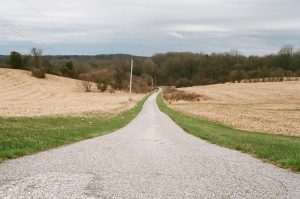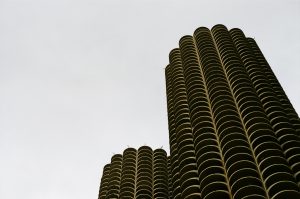Life in the Rear View
I spent six years working in broadcast journalism and nearly two years in digital marketing before coming to law school. Titles switched, duties expanded and employers changed, but intellectual property (“IP”), especially copyright, was always at the core. I existed in a constant state of media creation and consumption. Come along for the ride, and I’ll explain how.
Cruising Along
I spent the majority of my (pre-law) career in television production, working on the nationally televised automotive journalism show MotorWeek. I wrote over

200 scripts, produced videos, took photos, and supervised voice-over sessions. I posted to social media on a daily basis. I got to drive the newest, nicest, fastest, whatever-est cars on the market and call it “work.” Boiled down to its simplest truth, I was paid to create. I took pride in the works I made, and I was having fun.
Shifting Gears
As years went on my focus began to shift (get it?). I no longer saw my job as just creating media, releasing it to the world and relinquishing control.
I began to think about what happened to that media after.
Who owned it? I knew it wasn’t mine—my contract made it clear that my employer owned rights to all works created under employment. But what rights had I really given up? Who had ultimate ownership? MotorWeek? Maryland Public Television, the station that produced MotorWeek? Perhaps PBS, the network that made public television itself possible?
In addition, beyond who owned the creation, I had other questions. What could they do with it? What claim did I have to it?
Questions like these crept into my mind, and never left.
Taking a Detour
After a promotion, and an eventual change in employer, I found myself in a more artistic and less editorial role: Social Media Manager at a digital marketing agency. This role required me to rely on the works of others more than my own. Stock music and image libraries became my most used resources. These are basically massive catalogs of media that can be bought or licensed for a small fee (and some stock photos are subject to ridicule for their bizarrely specific subject matter).

Collaborating with graphic designers, web developers, video editors, and art directors became my daily routine. In addition to creating for myself, I was now consuming and distributing works created by others.
I remember frequent discussions of licensing agreements to use fonts, images, and songs. How many times could we use them? How long was the license valid? Was it only for use online, or could we use it in print? How can someone even copyright a font? (It turns out, you can copyright the source code of the font, but not the font itself…who knew?)
Seeing the Signs
I found these basic copyright issues fascinating, but I never found the answers satisfying. They were clear enough, written in (somewhat) plain English in various End User License Agreements (EULAs). These agreements dictated where you could publish, how many times you could use the media, if you were allowed to transfer it to anyone else, etc. All it seemed like to me was, “here’s what you can do, here’s what you can’t do.”
I wanted to know more. What underlying legal principles made up an EULA? What would happen if we violated it? What kind of lawyer did these creators use to draft this agreement?
My desire to understand took control as my desire to create took a backseat. I felt my passion for media production being overpowered by a passion to learn the legal concepts behind media production and how to protect created works. How do you address issues of ownership and fraud? Rights to distribute and publish? Questions of best practice? These were the types of things I wanted to know.
Input Destination: Loyola University Chicago School of Law
It didn’t take much digging to find that a law degree was the best way to achieve this goal, and IP was the area to study. As one career wound down, I saw another just starting up—and that inspired me. So, I began studying for the LSAT, applying to law schools, and doing as much research as I could. Chicago jumped out as the perfect city to start anew, and Loyola had a great reputation among the professionals I knew and alumni I read about.

That’s why I chose law school, that’s why I chose IP, and that’s why I chose Loyola.
Since arriving at here, I’ve been determined to pursue this path of study. I’ve joined this blog. I’m networking with attorneys who practice in copyright and trademark law—areas I hope to practice in. Even as a 1L, elective courses are allowed. I just finished taking “Global Access to Medicine: A Patent Perspective,” where we analyzed the cross-over between patent law and regulatory law in the pharmaceutical field and how they impact the ability to access medication. Do I have a science background? No! Did I understand what was going on all the time? No! But it was a fascinating course, and I gained exposure to areas of law I hadn’t previously considered in the realm of IP (and even beyond).
And that’s really what law school is all about, isn’t it?

Patrick Lucas
Assistant Blogger
Loyola University Chicago School of Law, J.D. 2022
